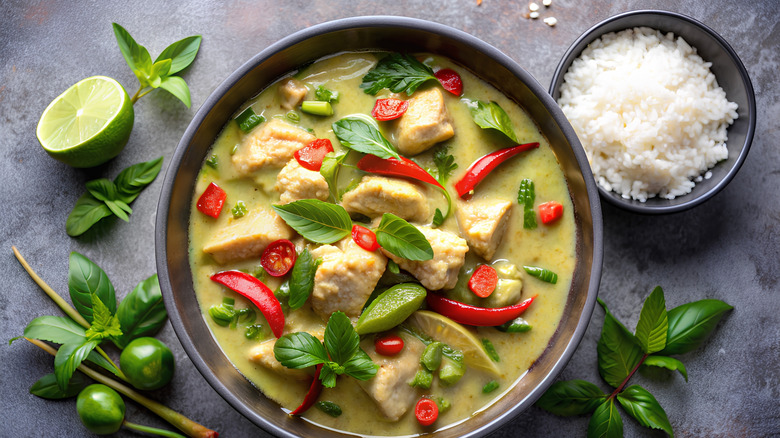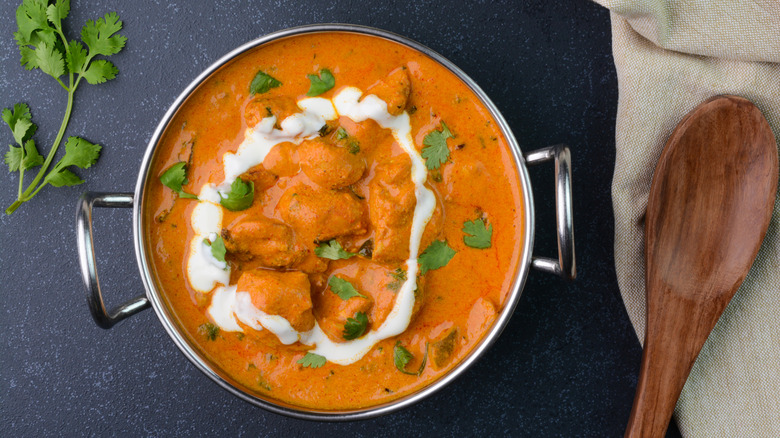The Difference Between Thai And Indian Curries
Ever wondered what makes Thai curry stand out from Indian? Though they both fall under the same umbrella, before colonization, each region has its own distinct name for curry. The British, for convenience, adapted the Portuguese word "caril" into "curry," lumping together all dishes with a sauce or gravy seasoned with spices. Technically, each "curry" is unique, though cultural similarities in preparation can be found. If you think in terms of barbeque sauce, Thai curry is more like a tangy Carolina-style — bright, fresh, and balanced. Meanwhile, Indian curry is a smoky Southern-style where the deep, layered flavors build over time.
When it comes to the spice profile, base ingredients, and cooking methods, Thai and Indian curries are significantly different. In Thai curries, coconut milk is often the base ingredient, adding a luscious creaminess and subtle sweetness to the recipe. However, some regions in Northern Thailand break away from this tradition because coconut trees are not part of the local flora. In contrast, Indian curries in the southern regions mostly use coconut. Another distinguishing feature in Thai curries is the use of palm sugar, which is virtually absent in Indian ones, except in a few rare dishes.
Key features of the sprightly Thai curry
Thai curries are wrapped in the vibrant aroma of fresh herbs like basil, lemongrass, coriander, and kaffir lime leaves. This is an element not typically seen in Indian curries, apart from the obvious curry leaves and, at times, coriander and mint. Each Thai curry has its own distinct personality, and the colors — red, green, and yellow — are simply ways to categorize them. Take phanaeng, for example: A rich, red curry made with meat and peanuts. Then there's hor mok pla, a delicate steamed fish curry, and kaeng kradang (hard curry), which has a jelly-like texture. Typically made with pork leg and pig ear, it's almost colorless or a lighter brown. Most Thai curries also have a tangy edge thanks to the addition of lime and tamarind, which adds a refreshing balance to the richness of the dish.
A defining characteristic of Thai curries is the spice paste — a carefully pounded mix of all the spices needed for a specific dish. It is usually made fresh, which is one of the reasons why Thai curries taste better at a restaurant than at home. Instead of adding each spice individually, the paste is sautéed in hot oil, releasing deep, layered flavors before any other ingredients are added. Common ingredients like shrimp paste and bird's eye chili pepper (prik kee nu, also known as "mouse-dropping chili" for its shape) bring the heat, making Thai curries stand out in both flavor and intensity. They also have a thinner consistency compared to Indian curries, owing to the addition of coconut milk. Indian curries, on the other hand, often rely on thickening agents like browned onions, tomatoes, and sometimes a bit of flour to create a more substantial texture.
Exploring the different facets of Indian curry
Indian curries are infused with the rich flavor of bold spices, where garam masala — a mix of ground spices that typically includes cardamom, cinnamon, cumin, and cloves — is considered the magic ingredient. Unlike Thai recipes, where fresh herbs like basil and kaffir lime dominate, Indian meals rely heavily on dried spices such as coriander and turmeric, besides the garam masala. Due to the country's vast regional diversity, the "curry'" morphs into the flavor of the culture it enters.
While dairy is heavily used in the northern parts of India, where you'll find dishes like creamy butter chicken or gushtaba (meatballs in yogurt gravy), it is almost absent in the southern regions. Curries in the southern parts, such as meen (fish) curry, have a thinner consistency, and curry leaves and coconut are regular features in most recipes. On the other hand, mustard is a dominant spice in the eastern region's dishes.
Despite these regional variations, Indian curries find commonality in their base ingredients — a mix of ginger, garlic, onions, tomatoes, and dry spices, like in our easy chicken curry recipe. So the next time you encounter someone who might be confused about the differences, you can explain it like a pro.


